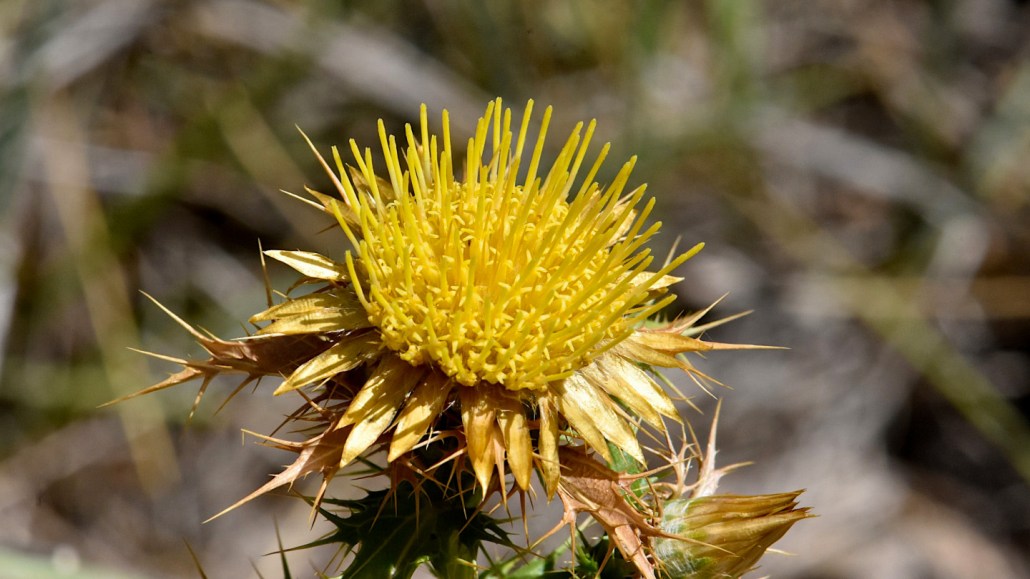On hot summer days, this thistle stays cool to the touch
Its yellow flowers can maintain lower temperatures even during peak heat

In southern Spain, summer heat can make life tough for a plant. The thistle Carlina corymbosa beats the heat by cooling its flowers to well below the temperature of the air around it.
Carlos Herrera
Share this:
- Share via email (Opens in new window) Email
- Click to share on Facebook (Opens in new window) Facebook
- Click to share on X (Opens in new window) X
- Click to share on Pinterest (Opens in new window) Pinterest
- Click to share on Reddit (Opens in new window) Reddit
- Share to Google Classroom (Opens in new window) Google Classroom
- Click to print (Opens in new window) Print
In the sun-drenched mountains of southern Spain, one type of thistle seems to have built-in air conditioning.
The flowers of this plant — Carlina corymbose — stay cooler than the hot air around them. Ecologist Carlos Herrera reports they are, on average, about 3 degrees Celsius (5.4 degrees Fahrenheit) cooler. But during the hottest part of the day, the temperature difference becomes even more extreme. The flowers can cool up to 10 degrees Celsius (18 degrees Fahrenheit).
So, when the air reaches a blazing 45 °C (113 °F), the plant’s flowers can remain a relatively chilled 35 °C (95 °F). Herrera shared his findings February 13 in Ecology.
“Those are substantial coolings relative to the air next to it,” says ecologist Christopher Still. He works at Oregon State University in Corvallis. He was not involved in the work, but says, “It’s a nice, careful study.”
A chance discovery
In Spain’s Sierra de Cazorla mountain range, scorching summers leave many plants dead, dried out or dormant. But in this brown sea, bursts of yellow thistle flowers peek above browned-out neighbors.
On a recent trek through the mountains, Herrera touched one of the thistle heads. Even though it was the peak of the day’s heat, the bloom felt pleasantly cool.
Herrera works at the Spanish National Research Council in Sevilla. But he was up in the mountains to study links between the region’s plants and their pollinators. He recalls bending over to touch the bloom because he “was checking for the presence of nectar in the flower head.”
But once he did, he became curious about why the flower felt chilled. He decided to find out more.
Using an electric thermometer, he measured the temperatures of seven thistles across two different sites. Herrera checked each bloom many times and on different days. The flowers grew consistently cooler as the day heated up.
Many plants beat the heat by letting water evaporate through tiny holes, or pores. This process is called transpiration. It’s similar to how people sweat to stay cool.
The chill factor
There’s been little research on how flowers keep their cool. Most studies have focused on a plant’s leaves. And leaves don’t usually get cooler than the air around them. When they do, Herrera reports, the difference is less drastic than was seen in these thistle flowers.
It’s certainly possible that the thistle cools itself down more than leaves, Still says. But because flowers and leaves are measured differently, it’s hard to say for sure.
The thistles started cooling down at the hottest part of the day. That might mean the plants are actively turning a self-refrigerating process on and off. However, Still notes, this is a rare skill for plants.
Both Herrera and Still think that the thistle flower’s shape and structure help it to cool off so well.
Do you have a science question? We can help!
Submit your question here, and we might answer it an upcoming issue of Science News Explores
As water within the thistle evaporates, it takes heat with it, Herrera suspects. Because of the flower’s shape, that heat isn’t being replaced by the sun’s warmth. This might allow the plant to cool below the air temperature. Herrera dubs this the “botijo effect.” It’s named after traditional Spanish water pitchers made of porous clay. They allow water to seep through and evaporate on the surface, cooling the remaining water inside. The idea that the thistle uses this process needs to be tested, however.
Herrera and Still are both curious to know how being cooler than the surrounding air helps the thistle. For example, does it attract pollinators trying to escape the oppressive summer heat? Herrera also plans to see if other thistles in southern Spain show the same cooling effect. He’s even designed an experiment to test how the plant’s cooling might change if it gets less water.
There’s a lot of value in observing the natural world, Still says. “This one study could lead to lots of cool follow-on work.”







